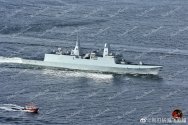YJ-83 and YJ-12 - don't fit UVLS.
Depending on the actual PLAN intentions for 054B, UVLS's U may not be all that U.
Physically they could, providing there is enough clearance for the intakes. In fact, the last Zhuhai, we have pics of YJ-83 on U-VLS in the placards and models, which suggest it may either be possible in the PLAN in the future and/or offered in export models.
What to remember is that the YJ-83 is turbojet powered and the YJ-12 is ramjet powered. The YJ-18 in comparison, at least in the cruise stage, is on a turbofan. A turbofan has a lower ignite airspeed than a turbojet, which in turn has a lower ignite speed than a ramjet. Thus, once the missile leaves the VLS, the YJ-18 can ignite its engines at a lower air speed, so you can use smaller boosters. A turbojet AshM on the other hand, needs to be traveling at a much higher airspeed to get air into its intakes, so for a smaller missile, you may need a bigger booster to get to that air speed. It is for that reason why these missiles are fired mainly slanted, so it takes less of a booster to get to that airspeed faster.
Considering the YJ-83 is rather small --- it weighs as much as an HQ-16 without the booster --- you would have to come up with a new booster for it. The current YJ-83 with existing booster is already 6.86 meters in length. So it would fit right in. But the existing booster won't get you the air speed need to ignite the engine, so you are going to need a new booster with a more energy dense propellant, although by now, solid propellant technology in China has advanced since the days the YJ-83 began its development.
There is that other alternative, that, is, to redesign the YJ-83 itself by replacing the turbojet with a turbofan. This can even give you a range increase with the efficiencies of the turbofan. The counter alternative to this is to offer the YJ-18 in a mini all subsonic version. That is, the AshM no longer is a twin stage one, but a whole solid subsonic single stage airframe. Without the twin stage, you can fit a shortened all subsonic YJ-18 in a 7 meter VLS, and also offer this in a subsonic land attack variant or dual seeker with anti ship or land attack.
As for the YJ-12, a ramjet requires an even much higher airspeed for ignition, but the missile itself uses an integral rocket chamber. That is, similar (copied?) from the Sunburn missile, the ramjet chamber is filled with solid fuel rocket propellant. Rockets ignite independently of air speed, you only need to flip the missile towards the right direction. So after the booster is fired, expended and ejected, the missile fires its integral rocket booster, and its on its way. Once the rocket fuel burns away, everything is clear in the ramjet chamber, and with sufficient airspeed, the ramjet can ignite.
This still leaves you with the question if there is enough solid fuel in the integral chamber to reach ignition speed. There is a question if the design with four diverters and intakes at the sides is the optimal design. This is probably why, for this reason, the Russians use a nose intake with a variable diverter cone, the design you see on the Oniks, for a VLS launched all supersonic route missile rather than the Sunburn's design. But then again, in Zhuhai, we already have seen a proposed Chinese AshM design model similar to the Oniks. But obviously, I don't think the PLAN is planning to go into this idea and is devoted to the YJ-18 and a ballistic missile based antiship missile.

